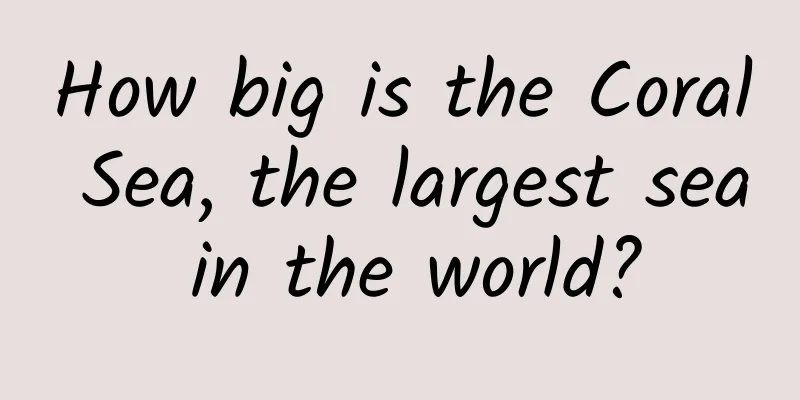How big is the Coral Sea, the largest sea in the world?

|
Produced by: Science Popularization China Author: Blue Ocean Team Producer: China Science Expo In the South Pacific, between Australia, Papua New Guinea, the Solomon Islands, the New Hebrides, New Caledonia and the 30th parallel south, there is a colorful sea called the Coral Sea. The Coral Sea is connected to the Solomon Sea in the north and the Tasman Sea in the south. It covers an area of nearly 5 million square kilometers and is the largest sea in the world. It is a marginal sea of the Pacific Ocean. It was once the world of coral polyps. They were so ingenious that they left behind the world's largest barrier reef. Numerous atoll islands and coral stone platforms are scattered on the vast ocean like flowers scattered by fairies, and hence the name Coral Sea. (Photo source: veer photo gallery) The Coral Sea is located in the tropics, with a water temperature between 18-28℃ all year round. The wind speed is low, the sea is calm, and the water is clean, which is conducive to the growth of corals. It is famous for its numerous coral reefs. Here are the three largest coral reefs in the world, namely the Great Barrier Reef, the Tagula Barrier Reef and the New Caledonia Barrier Reef. The Great Barrier Reef is the largest, located in the northeast of Australia, only 16 kilometers from the shore at its closest point and more than 240 kilometers at its farthest point. The Great Barrier Reef lies there like a long strip, more than 2,000 kilometers long, 150 kilometers wide at its widest point from east to west, and covers an area of about 80,000 square kilometers. Most of its reefs are submerged underwater, and those exposed above the sea surface become coral islands. More than 500 coral islands are scattered over more than 900 square kilometers of sea surface, with dense tropical jungles on the islands, lush and green; beside the silvery sandy beaches, colorful coral reef platforms can be seen under the blue water outside the beaches. There is plenty of sunshine, fresh air, clean sea water, and rugged reefs here, making it a paradise for marine life. (Photo source: veer photo gallery) The beautiful environment has become a good place for people to travel. On the larger islands, there are airports and ports, and tourists come and go conveniently by plane or cruise ship. People row boats, swim, sunbathe and take sand baths here. You can also sit in a sightseeing boat with a glass bottom to enjoy the wonderful underwater world. The fish and shrimps in various shapes and colors and seashells in different colors are a feast for your eyes. Parrot fish wearing red and green ribbons are swallowing corals; crystal-clear trumpet fish are daring to bite your hand; the light and tiny gill fish dare to bite your hand; the arrogant sea turtles are not panicked in front of strangers; the underwater coral world, under the sunlight, is colorful in red, yellow and blue; or branch-shaped, or human brain-shaped, or like willow branches, or like flowers, in various shapes and shapes, which are fascinating. (Photo source: veer photo gallery) Corals look like plants, but they are actually a kind of ten-level animal in the ocean. A piece of coral is often a group of hundreds of billions of coral polyps. Living corals are colorful in the seawater, yellow, green, purple, red, and the colors are bright and eye-catching. They are called flowers of the seabed. The white corals we see in daily life are the remains and skeletons left after the corals die. Coral polyps are very small and can only be seen clearly under a microscope. They have no eyes or noses, only sensitive tentacles, which are their sensory organs. The tentacles drift slowly with the water flow, freely retracting and catching plankton and debris passing by. When frightened, they immediately retract and hide their tentacles. In the center of the tentacles, there is a small opening, which is the mouth of the coral polyp, called the "oral passage". The oral passage is a straight intestine, without an esophagus or stomach. It spits out the digested residues through the oral passage, and the anus and mouth are inseparable, so it is not unfair to call it a low-level animal. (Photo source: veer photo gallery) The reproduction of tiny coral polyps is neither like a hen laying eggs to hatch chicks nor like a sow giving birth to piglets. Corals reproduce by splitting, and the speed is amazing. They can split into two, two into four, and in the blink of an eye, they have many children and grandchildren. But they are all on a coral body, you press me, I squeeze you, and it is difficult to distinguish between the father and the younger generation. Some coral polyps also reproduce sexually, through the combination of sperm and eggs, they produce floating larvae, which are discharged from the mouth and drift with the water. When they encounter a suitable place, they attach and stand firm, develop into coral polyps, and gradually grow into a group. Colony corals reproduce very quickly, and the old ones continue to die, leaving skeletons to become reefs; new coral polyps continue to climb on the bones of their predecessors. In this way, the predecessors fall down and become paving stones, and the younger generations step on the bones of their predecessors to continue to build new peaks. One coral reef after another is built in this way. The Great Barrier Reef and other atolls and reefs have also gone through such a process. (Photo source: veer photo gallery) Not all corals can build reefs. Only corals with lime in their bodies, such as stony corals, staghorn corals, and multi-branched rose corals, have this ability. Also contributing to reef building are the zooxanthellae in the corals. It is a single-cell algae, very small in size. 1,000 zooxanthellae together are only as big as a grain of rice. It performs photosynthesis in the sun, absorbs carbon dioxide, releases fresh oxygen, and turns nitrogen, phosphorus, and potassium into organic matter, which is used as nutrition to supply the growth needs of coral polyps, making corals full of vitality and gorgeous. When the environment becomes cold, the zooxanthellae flee, and the corals lose nutrition, quickly become dull, wither, and die. The fact that there are so many coral reefs in the Coral Sea today shows that during the reef-building period, there were not only a large number of reef-building corals, but also vigorous zooxanthellae that grew and reproduced here. Their successful cooperation makes the Coral Sea so colorful. |
>>: Why do urine tests require “midstream urine”? Will the front and back urine affect the results?
Recommend
Huihui's "Operational Anchor Explosive Traffic Practical Training Camp" helps to increase performance and break through traffic bottlenecks
Training course content: Ranked fifth on Douyin&#...
Why is flour not as fragrant as before? Is it safe to add additives? The truth is...
Flour is a food we often eat. Dumplings, steamed ...
Richard Foster: Barbarians in the field of new energy vehicles represent the future. Innovation is the way for autonomous driving to survive.
In recent years, with the recognition of the ener...
Miaopu Personal Information: Is SEO keyword optimization ineffective? Details cannot be ignored
Now when we are doing SEO optimization, many webs...
Practical tips: How to increase followers on Douyin?
Recently, some people have been asking, “Why is T...
YOGA Goddess Training Camp-Slimming Yoga Class
Course catalog: Lesson 01: If you don’t breathe co...
Unlock the most in-trend advertising methods on Tencent and iQiyi
Effective attention is the starting point of all ...
A must-have hot search tool for new media professionals!
Since I started writing, I have had a few fans ad...
18 lessons on "Making Money by Selling Goods Online" to teach you how to write hot-selling and profitable copywriting
18 Lesson Outline of "Making Money by Sellin...
Generate 10-day weather forecast in 1 minute, AI beats the world's best forecasting system
When it comes to weather forecasting, artificial ...
Bidding promotion: 6 secrets to high conversion!
A few days ago, someone chatted with me and said:...
Speed and security are both available! Transforming asynchronous layout greatly improves client layout performance
1. Background As the user scale of Xiaohongshu co...
Top 10 Marketing Keywords in 2020
Looking back at 2020, although affected by the ep...
Automobile production and sales exceeded 28 million units, and China's automobile market gradually returned to rationality
2016 is the first year of the 13th Five-Year Plan...
How to place Momo information flow ads? Just look at this and you will know!
When the word "Momo" comes into view, a...









